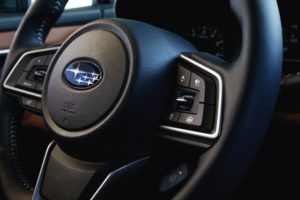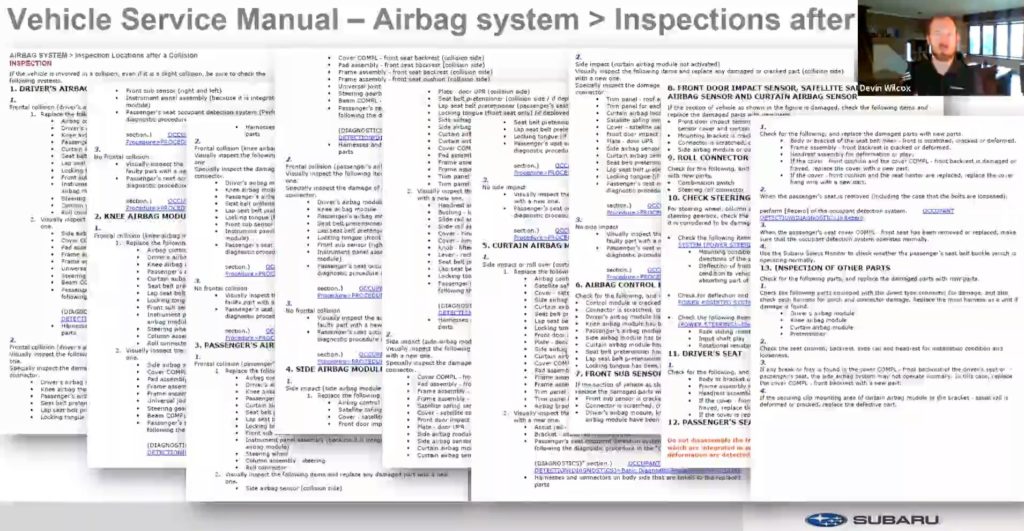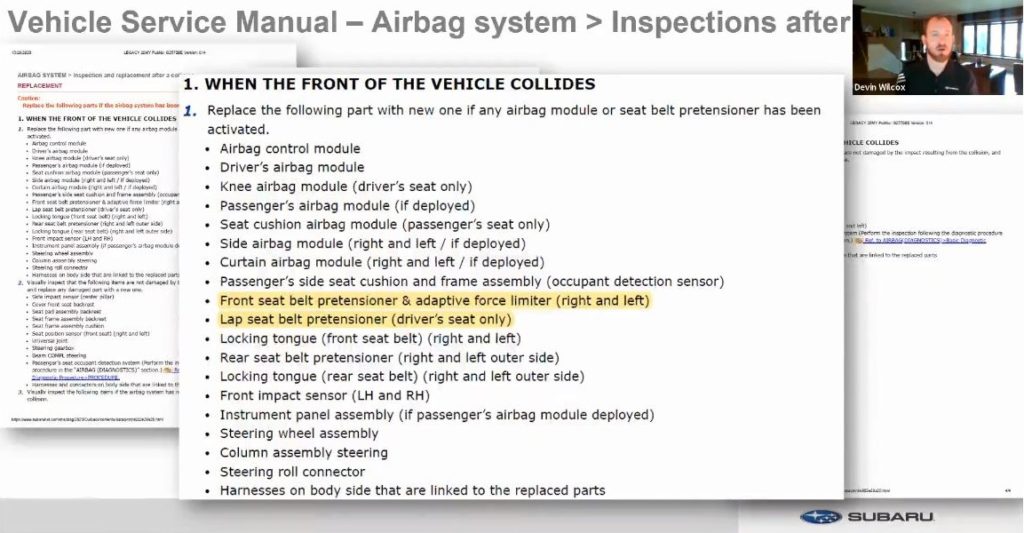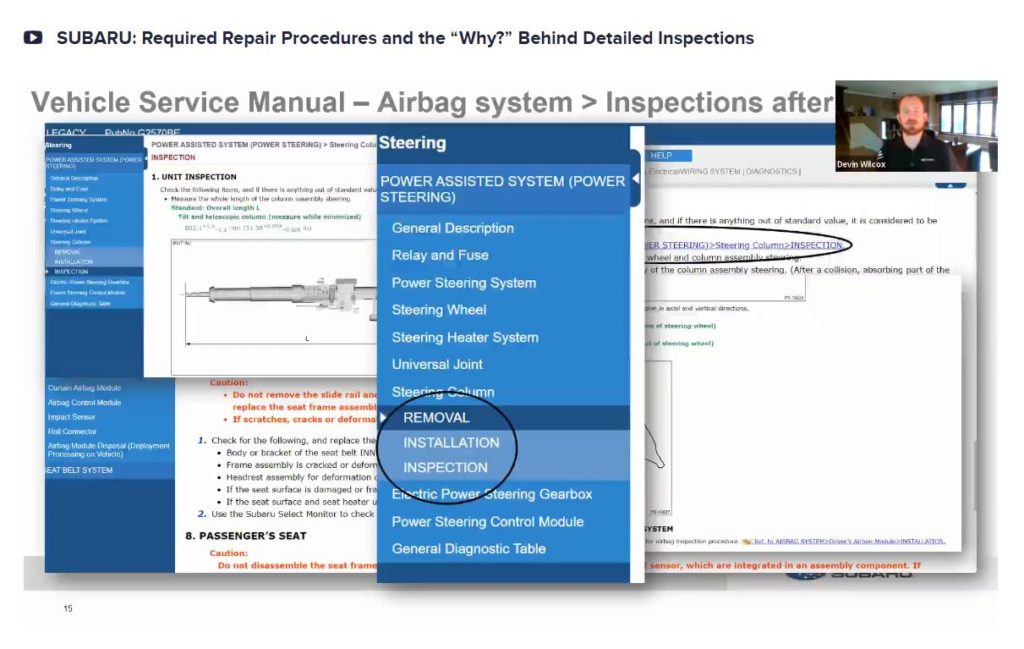
Subaru offers tips on vehicle checks following a collision
By onAssociations | Education | Repair Operations | Technology
Subaru in the 2020 virtual OEM Collision Repair Technology Summit highlighted the numerous inspections it can require following a collision and offered body shops a couple of pointers on the process.
In the recent video lecture, available for replay on rde.scrs.com through Aug. 31, 2021, Subaru collision certification manager Devin Wilcox showed how the post-collision inspection procedures for an unspecified model could span nine pages.
“If the vehicle is involved in a collision, even if it is a slight collision, be sure to check the following systems,” Subaru wrote at the beginning of instructions shown during the presentation.
Wilcox noted that Subaru explained the term “collision” in the company’s pre- and post-repair scanning position statement.
“Subaru defines a collision as damage that exceeds minor outer body panel cosmetic distortion,” the document states.
This definition meant that “hitting a rabbit is not gonna cause a $10,000 repair bill, unless the rabbit caused more than outer body panel cosmetic distortion,” Wilcox said.
Another slide in the presentation showed a four-page set of part replacements potentially required after impacts to various parts of that unspecified Subaru.
Wilcox pointed out a subtlety in the instructions here for front-end collision scenario with an airbag module or seat belt pretensioner activation.
The document called for the replacement of the “Front seat belt pretensioner & adaptive force limiter (right and left),” but the “driver’s seat only” lap seat belt pretensioner.
There’s no passenger lap pretensioner on that particular vehicle, Wilcox explained. It’s important for techs to go through OEM procedures “top to bottom” and validating them, he said. In this case, it would have prevented the shop from ordering an extra pretensioner needlessly.
Wilcox also addressed what he said were inquiries on the removal of the steering column. Subaru requires the shop to check the component and other related items after a collision, according to instructions for a model shown within the presentation.
A shop can click on a hyperlink within those instructions on STIS, Subaru’s OEM procedures website, and pull up an inspection procedure for the steering column, Wilcox said.
The left-hand side of the screen in STIS provides the user the option of selecting select steering column removal, installation and inspection instructions, according to Wilcox.
It’s important to measure the steering column to verify it meets Subaru’s specifications, Wilcox said. A compressed steering column won’t behave as expected during a subsequent crash, he said.
Removing the column has a nuance some repairers might miss. “Disconnect the ground terminal from the battery sensor, and wait for at least 60 seconds before starting work,” an OEM repair procedure states.
If the battery wasn’t disconnected, the vehicle will throw a diagnostic trouble code visible in the post-repair scan, Wilcox said.
It’s also important to mirror-match a replacement steering column and validate it wasn’t affected while being shipped to the shop, according to Wilcox. He said Subaru has heard of instances where a replacement column might have been dropped in transit, compressing the part and making it “not suitable to be reinstalled into one of our vehicles.”
“Subaru really prides itself on the safety of our vehicles,” Wilcox said. He said the company’s vehicle owners expect a sort of “family idea” with the brand. This means not just their family within a vehicle but also Subaru’s “family of vehicles” protecting them and a family of dealerships and auto body shops, he said.
Subaru owners take a great pride in ownership and their brand, Wilcox said. They even read manuals in their free time, he said.
The Subaru brand concentrates on “three core pillars”: longevity, adventure/versatility, and safety, he said. Subaru has a “commitment to safety,” he said.
This commitment extends to how owners would be protected if a collision occurs, he said.
Wilcox’s presentation, the rest of the virtual OEM Collision Repair Technology Summit and the 17 regular virtual Repairer Driven Education courses can be accessed at rde.scrs.com. Courses generally cost $75. One class is free, and the OEM Summit charges $150 admission. A full-series pass good for all 17 regular classes and the OEM Summit is available for $375. All virtual courses are replayable through Aug. 31, 2021.
More information:
Subaru OEM repair procedures website
SCRS virtual OEM Collision Repair Technology Summit
SCRS virtual Repairer Driven Education
Images:
Subaru collision certification manager Devin Wilcox showed in the 2020 virtual Repairer Driven Education OEM Summit how the post-collision inspection procedures for one Subaru model span nine pages. (Subaru slide; screenshot from Society of Collision Repair Specialists video)
Subaru collision certification manager Devin Wilcox pointed out a subtlety in the procedures following a front-end collision and an airbag module or seat belt pretensioner activation. The document called for the replacement of the “Front seat belt pretensioner & adaptive force limiter (right and left),” but the “driver’s seat only” lap seat belt pretensioner. (Subaru slide; screenshot from Society of Collision Repair Specialists video)
During the 2020 virtual OEM Collision Repair Technology Summit, Subaru collision certification manager Devin Wilcox showed how to find instructions for removing a Subaru steering column within the techinfo.subaru.com OEM repair procedures website. (Subaru slide; screenshot from Society of Collision Repair Specialists video)



